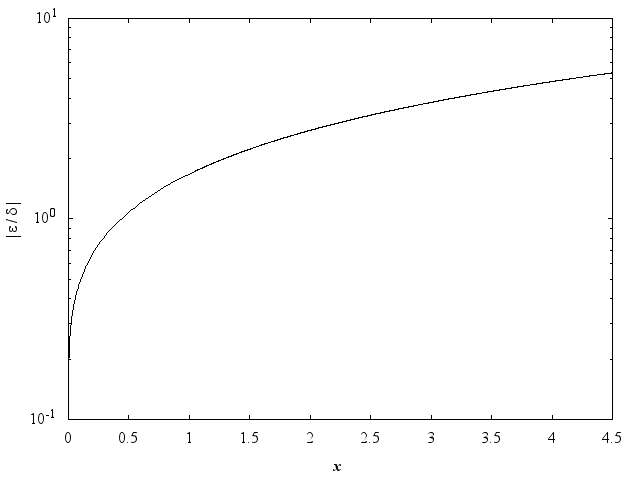PDF version (NAG web site
, 64-bit version, 64-bit version)
NAG Toolbox: nag_specfun_integral_exp (s13aa)
Purpose
nag_specfun_integral_exp (s13aa) returns the value of the exponential integral , via the function name.
Syntax
Description
nag_specfun_integral_exp (s13aa) calculates an approximate value for
using Chebyshev expansions, where
is real. For
, the real part of the principal value of the integral is taken. The value
is infinite, and so, when
,
nag_specfun_integral_exp (s13aa) exits with an error and returns the largest representable machine number.
For
,
where
.
For
,
where
.
In both cases, .
For
, the approximation is based on expansions proposed by
Cody and Thatcher Jr. (1969). Precautions are taken to maintain good relative accuracy in the vicinity of
, which corresponds to a simple zero of Ei(
).
nag_specfun_integral_exp (s13aa) guards against producing underflows and overflows by using the argument . To guard against overflow, if the function terminates and returns the negative of the largest representable machine number. To guard against underflow, if the result is set directly to zero.
References
Abramowitz M and Stegun I A (1972) Handbook of Mathematical Functions (3rd Edition) Dover Publications
Cody W J and Thatcher Jr. H C (1969) Rational Chebyshev approximations for the exponential integral Ei Math. Comp. 23 289–303
Parameters
Compulsory Input Parameters
- 1:
– double scalar
-
The argument of the function.
Constraint:
or .
Optional Input Parameters
None.
Output Parameters
- 1:
– double scalar
The result of the function.
- 2:
– int64int32nag_int scalar
unless the function detects an error (see
Error Indicators and Warnings).
Error Indicators and Warnings
Errors or warnings detected by the function:
Cases prefixed with W are classified as warnings and
do not generate an error of type NAG:error_n. See nag_issue_warnings.
- W
-
On entry, and the function is infinite. The result returned is the largest representable machine number.
-
-
The evaluation has been abandoned due to the likelihood of overflow. The argument , and the result is returned as the negative of the largest representable machine number.
-
An unexpected error has been triggered by this routine. Please
contact
NAG.
-
Your licence key may have expired or may not have been installed correctly.
-
Dynamic memory allocation failed.
Accuracy
Unless stated otherwise, it is assumed that .
If
and
are the relative errors in argument and result respectively, then in principle,
so the relative error in the argument is amplified in the result by at least a factor
. The equality should hold if
is greater than the
machine precision (
due to data errors etc.) but if
is simply a result of round-off in the machine representation, it is possible that an extra figure may be lost in internal calculation and round-off.
The behaviour of this amplification factor is shown in the following graph:
Figure 1
It should be noted that, for absolutely small
, the amplification factor tends to zero and eventually the error in the result will be limited by
machine precision.
For absolutely large
,
the absolute error in the argument.
For , empirical tests have shown that the maximum relative error is a loss of approximately decimal place.
Further Comments
None.
Example
The following program reads values of the argument from a file, evaluates the function at each value of and prints the results.
Open in the MATLAB editor:
s13aa_example
function s13aa_example
fprintf('s13aa example results\n\n');
x = [2 -1];
n = size(x,2);
result = x;
for j=1:n
[result(j), ifail] = s13aa(x(j));
end
disp(' x E_1(x)');
fprintf('%12.3e%12.3e\n',[x; result]);
s13aa_plot;
function s13aa_plot
x = [-5:0.1:-0.2, -0.1:0.01:-0.01, -1e-3, -1e-4, -1e-5...
1e-5, 1e-4, 1e-3, 0.01:0.01:0.1, 0.2:0.1:4.8];
for j=1:numel(x)
[e1(j), ifail] = s13aa(x(j));
end
fig1 = figure;
plot(x,e1);
xlabel('x');
ylabel('E_1(x)');
title('Exponential Integral E_1(x)');
s13aa example results
x E_1(x)
2.000e+00 4.890e-02
-1.000e+00 -1.895e+00
PDF version (NAG web site
, 64-bit version, 64-bit version)
© The Numerical Algorithms Group Ltd, Oxford, UK. 2009–2015

